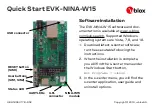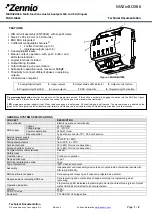
MB966B0 Series
F
2
MC-16FX 16-Bit Microcontroller
Cypress Semiconductor Corporation
• 198 Champion Court • San Jose
,
CA 95134-
1709 • 408-943-2600
Document Number: 002-04721 Rev.*A
Revised March 3, 2016
MB966B0 series is based on Cypress advanced F
2
MC-16FX architecture (16-bit with instruction pipeline for RISC-like performance).
The CPU uses the same instruction set as the established F
2
MC-16LX family thus allowing for easy migration of F
2
MC-16LX
Software to the new F
2
MC-16FX products.
F
2
MC-16FX product improvements compared to the previous generation include significantly improved performance - even at the
same operation frequency, reduced power consumption and faster start-up time.
For high processing speed at optimized power consumption an internal PLL can be selected to supply the CPU with up to 32MHz
operation frequency from an external 4MHz to 8MHz resonator. The result is a minimum instruction cycle time of 31.2ns going
together with excellent EMI behavior. The emitted power is minimized by the on-chip voltage regulator that reduces the internal CPU
voltage. A flexible clock tree allows selecting suitable operation frequencies for peripheral resources independent of the CPU speed.
Features
Technology
0.18
m CMOS
CPU
F
2
MC-16FX CPU
Optimized instruction set for controller applications
(bit, byte, word and long-word data types, 23 different
addressing modes, barrel shift, variety of pointers)
8-byte instruction queue
Signed multiply (16-bit
16-bit) and divide (32-bit/16-bit)
instructions available
System clock
On-chip PLL clock multiplier (
1 to
8,
1 when PLL stop)
4MHz to 8MHz crystal oscillator
(maximum frequency when using ceramic resonator
depends on Q-factor)
Up to 8MHz external clock for devices with fast clock input
feature
32.768kHz subsystem quartz clock
100kHz/2MHz internal RC clock for quick and safe startup,
clock stop detection function, watchdog
Clock source selectable from mainclock oscillator, subclock
oscillator and on-chip RC oscillator, independently for CPU
and 2 clock domains of peripherals
The subclock oscillator is enabled by the Boot ROM
program controlled by a configuration marker after a Power
or External reset
Low Power Consumption - 13 operating modes (different
Run, Sleep, Timer, Stop modes)
On-chip voltage regulator
Internal voltage regulator supports a wide MCU supply
voltage range (Min=2.7V), offering low power consumption
Low voltage detection function
Reset is generated when supply voltage falls below
programmable reference voltage
Code Security
Protects Flash Memory content from unintended read-out
DMA
Automatic transfer function independent of CPU, can be
assigned freely to resources
Interrupts
Fast Interrupt processing
8 programmable priority levels
Non-Maskable Interrupt (NMI)
CAN
Supports CAN protocol version 2.0 part A and B
ISO16845 certified
Bit rates up to 1Mbps
32 message objects
Each message object has its own identifier mask
Programmable FIFO mode (concatenation of message
objects)
Maskable interrupt
Disabled Automatic Retransmission mode for Time
Triggered CAN applications
Programmable loop-back mode for self-test operation
USART
Full duplex USARTs (SCI/LIN)
Wide range of baud rate settings using a dedicated reload
timer
Special synchronous options for adapting to different
synchronous serial protocols
LIN functionality working either as master or slave LIN
device
Extended support for LIN-Protocol with 16-byte FIFO for
selected channels to reduce interrupt load
I
2
C
Up to 400kbps
Master and Slave functionality, 7-bit and 10-bit addressing
A/D converter
SAR-type
8/10-bit resolution
Signals interrupt on conversion end, single conversion
mode, continuous conversion mode,
stop conversion mode, activation by software, external
trigger, reload timers and PPGs
Range Comparator Function
Scan Disable Function
ADC Pulse Detection Function
Source Clock Timers
Three independent clock timers (23-bit RC clock timer,
23-bit Main clock timer, 17-bit Sub clock timer)


































